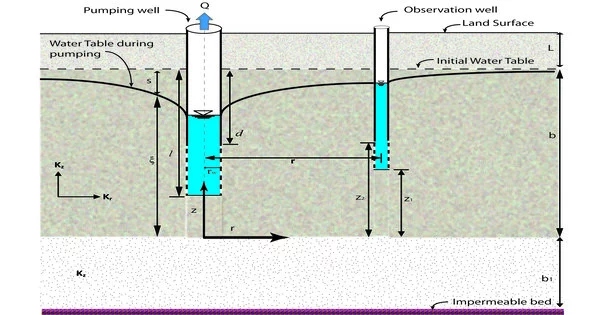An aquifer test (or pumping test) is used in hydrogeology to evaluate an aquifer by “stimulating” it with steady pumping and measuring the aquifer’s “response” (drawdown) in observation wells. It is a hydrogeological approach for determining an underground aquifer’s hydraulic qualities.
Aquifer testing is a typical tool used by hydrogeologists to characterize an aquifer, aquitard, and flow system boundary system. Aquifers are subsurface rock or sediment layers that can store and transport water. Understanding their features is essential for managing groundwater resources, building efficient wells, and assessing the potential environmental implications of groundwater extraction.
A slug test is an aquifer test variant in which an immediate alteration (increase or decrease) is made and the results are observed in the same well. This is frequently used in geotechnical engineering contexts to provide a rapid assessment of the aquifer parameters immediately surrounding the well (in minutes rather than days).
Here are the key components and steps involved in conducting an aquifer test:
(a) Well Installation: The first stage is to dig a well or prepare an existing well for testing. This well is commonly known as the “test well” or “observation well.” It should be installed in the aquifer of interest and should be deep enough to reach the intended testing zone inside the aquifer.
(b) Pumping or Injection: The next step is to either pump water out of the test well at a steady rate or inject water into it. The rate of pumping or injection, as well as the duration of the test, are essential design parameters.
(c) Monitoring Wells: One or more monitoring wells are often installed at prescribed distances around the test well. These monitoring wells are used to record changes in water levels as the test progresses. The data collected from these wells is used to analyze the aquifer’s response to pumping or injection.
(d) Data Collection: As the test proceeds, water level measurements are continuously recorded in the monitoring wells. This data is usually collected at specific time intervals and can provide information about the drawdown (lowering of the water table) caused by pumping or the increase in water level during injection.
(e) Data Analysis
The data collected during the aquifer test is analyzed to determine several hydraulic properties of the aquifer, including:
- Transmissivity: This property represents the ability of the aquifer to transmit water. It is calculated from the rate of drawdown in the test well and the distance from the well to the monitoring wells.
- Hydraulic Conductivity: Hydraulic conductivity measures how easily water flows through the aquifer material. It is calculated based on transmissivity and the thickness of the aquifer.
- Storage Coefficient: This property describes the ability of the aquifer to store water. It is determined from the rate of water level decline and the rate of pumping.
- Well-Efficiency: Well-efficiency measures how efficiently the test well can access water from the aquifer. It is calculated based on the relationship between the drawdown in the test well and the drawdown in the pumping well.
(f) Interpretation
The aquifer test findings are evaluated to better understand the aquifer’s features, such as its ability to support a given rate of pumping without producing undue decline or depletion.
Applications
Aquifer test results are utilized in a variety of applications, including groundwater resource management, well design, and environmental impact assessments. It contributes to the long-term use of groundwater and the preservation of groundwater-dependent ecosystems.
















